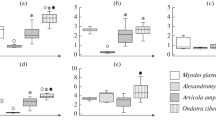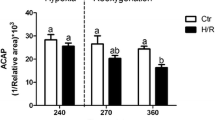Abstract
Physiological role of catalase in mechanisms of adaptive reactions to hypoxic influences in diving rodents, muskrats Ondatra zibethica, has been investigated. The myocardial tissues were established to be the most resistant to the oxidative stress produced by hypobaric hypoxia-reoxygenation. An intraperitoneal injection of a specific nonreversible catalase inhibitor, 3-amino-1, 2, 4-triazol (3-AT), at a dose of 1 g/kg body weight, on the background of the diving hypoxia-reoxygenation decreased the catalase activity in liver, kidney, heart, and brain tissues, on average, by 83%. No statistically significant changes of this activity were observed in the femoral muscle tissue. In 56.5 min after the injection, the tissue concentrations of 3-AT in liver, kidney, heart, and femoral muscle were approximately similar to amount to about 1 µg/mg wet tissue. The 3-AT concentration in the brain was three times lower than in other tissues; however, this practically did not affect the extent of catalase inhibition. During the diving hypoxia-reoxygenation the reduction of catalase activity under effect of 3-AT was accompanied by an increase of lipid peroxidation (LPO) only in the heart and liver, which indicates an important role of catalase in protection of these tissues from damaging effects of active oxygen forms at resumed external respiration after the long diving.
Similar content being viewed by others
REFERENCES
Ogura, Y., Catalase Activity at High Concentration of Hydrogen Peroxide, Arch. Biochem. Biophys., 1955, vol. 57, pp. 288-300.
Floche, L. and Braud, I., Kinetics of Glutathione Peroxidase, Arch. Biochem. Biophys., 1969, vol. 191, pp. 541-549.
Rubina, Kh.M., Biochemistry of Erythrocytes, Fiziologiya sistemy krovi. Fiziologiya eritropoeza (Rukovodstvo po fiziologii) (Physiology of Blood System. Physiology of Erythropoesis. Handbook of Physiology), Leningrad, 1979, pp. 211-232. Table 3. Distribution of 3-amino-1, 2, 4-triazole and the degree of catalase inhibition in muskrat tissues Liver Kidney Myocardium Femoral muscle Brain 3-amino-1, 2, 4-triazole concentration (?g/mg tissue) 1.04 ± 0.21 1.36 ± 0.12 0.91 ± 0.12 1.00 ± 0.09 0.36 ± 0.10 Percent inhibition of catalase activity (%) 93 ± 2 82 ± 10 82 ± 9 58 ± 50 82 ± 7 95 JOURNAL OF EVOLUTIONARY BIOCHEMISTRY AND PHYSIOLOGY Vol. 38 No. 1 2002 POSSIBLE ROLE OF CATALASE IN ADAPTATION TO DIVING
Jacob, H.S., Ingbar, S.H., and Jandl, J.H., Oxidative Hemolysis and Erythrocyte Metabolism in Hereditary Acatalasia, J. Clin. Invest., 1965, vol. 44, pp. 1187-1199.
Mueller, S., Riedel, H.-D., and Stremmel, W., Direct Evidence for Catalase as the Predominant H2O2-Removing Enzyme in Human Erythrocytes, Blood, 1997, vol. 90, pp. 4973-4978.
Masaki, H., Okono, Y., and Sakuria, H., Differential Role of Catalase and Glutathione Peroxidase in Cultured Human Fibroblasts under Exposure of H2O2 or Ultraviolet B Light, Arch. Dermatol. Res., 1998, vol. 290, pp. 113-118.
Karmazyn, M., Mailer, K., and Currie, R.W., Acquisition and Decay of Heat-Shock-Enhanced Postischemic Ventricular Recovery, Am. J. Physiol., 1990, vol. 259, pp. H424-H431.
Kingma, J.G., Simard, D., Rouleau, J.R., Tanguay, R.M., and Currie, R.W., Effect of 3-Aminotriazole on Hyperthermia-Mediated Cardioprotection in Rabbits, Am. J. Physiol., 1996, vol. 270, pp. H1165-H1171.
Auyeung, Y., Sievers, R.E., Weng, D., Barbosa, V., and Wolfe, C.L., Catalase Inhibition with 3-Amino-1, 2, 4-triazole Does not Abolish Infarct Size Reduction in Heat-Shocked Rats, Circulation, 1995, vol. 92, pp. 3318-3322.
Storey, K.B., Oxidative Stress: Animal Adaptations in Nature, Braz. J. Med. Biol. Res., 1996, vol. 29, pp. 1715-1733.
Retskii, M.I., Buzlama, V.S., Meshcheryakov, N.P., Rogacheva, T.E., and Shanaeva, L.V., Lipid Peroxide Oxidation and the Antioxidant Protection System in Marine and Terrestrial Mammals, Vsesoyuznaya konferentsiya “Fiziologiya morskikh zhivotnykh” (All-Union Conference “Physiology of Marine Animals”), Apatites, 1989, pp. 110-111.
Korobov, V.N., Klimishin, N.I., Pavlyuk, N.V., Strubitskii, I.V., and Basalkevich, E.E., Comparative Analysis of Oxygen-Binding and Antioxidant Properties of Blood in the Laboratory Animals and Muskrat Ondatra zibethica, Zh. Evol. Biokhim. Fiziol., vol. 31, pp. 369-371.
Galantsev, V.P., Kovalenko, R.I., Krivoruchko, B.I., Loshchagin, O.V., Poleshchuk, V.A., Smirnov, A.V., and Yanvareva, I.N., About Peculiarities of Tolerance to Oxygen Deficit in Rodents Non-Adapted and Adapted to the Aquatic Way of Life, Zh. Evol. Biokhim. Fiziol., 1999, vol. 35, pp. 43-47.
Ilyukha, V.A., Antioxidant Enzymes at Adaptations of Mammals of Different Ecogenesis, III Vsesoyuznyi mezhdunarodnyi simpozium “Fiziologicheskie mekhanizmy prirodnykh adaptatsii” (III All-Union International Symposium “Physiological Mechanisms of Natural Adaptations”), Ivanovo, 1999, pp. 72-73.
Ivashev, M.N., Kupin, A.G., Meertsuk, F.E., and Medvedev, O.S., Systemic and Regional Hemodynamics in the Laboratory Rats and Wild Muskrats during Diving, Sechenov Fiziol. Zh., 1992, vol. 78, pp. 41-46.
Loshchagin, O.V., Kovalenko, R.I., Yanvareva, I.N., and Kuz'min, D.A., Role of Catalase in Developing Adaptive Responses in Diving Mammals: Protection from Reperfusional Damage, Vestnik St. Petersburg Gos. Univ., 1999, Ser. 3 (issue 2), no. 10, pp. 86-90.
Galantsev, V.P., Kovalenko, R.I., Kuz'min, D.A., and Loshchagin, O.V., Study of Resistance of the Muskrat Ondatra zibethicus to Hypoxic Actions during Diving, Zh. Evol. Biokhim. Fiziol., 1999, vol. 35, pp. 156-157.
Heim, W.G., Appleman, D., and Pyfrom, H.T., Production of Catalase Changes in Animals with 3-Amino-1, 2, 4-Triazole, Science, 1955, vol. 122, pp. 693-694.
Luck, H., Catalase, Methods in Enzymological Analysis, 1963, vol. 27, pp. 885-895.
Beers, R.F. and Sizer, I.W., A Spectrophotometric Method for Measuring the Breakdown of Hydrogen Peroxide by Catalase, J. Biol. Chem., 1952, vol. 195, pp. 133-140.
Esterbauer, H. and Cheesman, U., Determination of Aldehydic Lipid Peroxidation Products: Malonaldehyde and 4-Hydroxymalonaldehyde, Methods in Enzymology, San Diego, 1990, vol. 186, pp. 302-310.
Green, F.O. and Feinstein, R.N., Quantitative Estimation of 3-Amino-1, 2, 4-Triazole, Analyt. Chem., 1957, vol. 29, pp. 1658-1660.
Godecke, A., Flogel, U., Zanger, K., Ding, Z., Hirchenhain, J., Decking, U.K.M., and Schrader, J., Disruption of Myoglobin in Mice Induces Multiple Compensatory Mechanisms, Proc. Natl Acad. Sci. USA, 1999, vol. 96, pp. 10 495-10 500.
Deisseroth, A. and Dounce, A. L., Catalase: Physical and Chemical Properties, Mechamism of Catalysis, and Physiological Role, Physiol. Rev., 1970, vol. 50, pp. 319-375.
Simmons, T.W. and Jamall, I.S., Relative Importance of Intracellular Glutathione Peroxidase and Catalase in vivo for Prevention of Peroxidation to the Heart, Cardiovasc. Res., 1989, vol. 23, pp. 774-779.
Lei, B., Adachi, N., and Arai, T., The Effect of Hypothermia on H2O2 Production during Ischemia and Reperfusion: ` Microdialysis Study in the Gerbil Hippocampus, Neurosci. Lett., 1997, vol. 222, pp. 91-94.
Odden, A., Folkow, L.P., Caputa, M., Hotvedt, R., and Blix, A.S., Brain Cooling in Diving Seals, Acta Physiol. Scand., 1999, vol. 166, pp. 77-78.
Author information
Authors and Affiliations
Rights and permissions
About this article
Cite this article
Loshchagin, O.V., Kovalenko, R.I., Nozdrachev, A.D. et al. Possible Role of Catalase in Adaptation to Diving of Semi-Aquatic Rodents Ondatra zibethica . Journal of Evolutionary Biochemistry and Physiology 38, 90–95 (2002). https://doi.org/10.1023/A:1015577607316
Issue Date:
DOI: https://doi.org/10.1023/A:1015577607316




